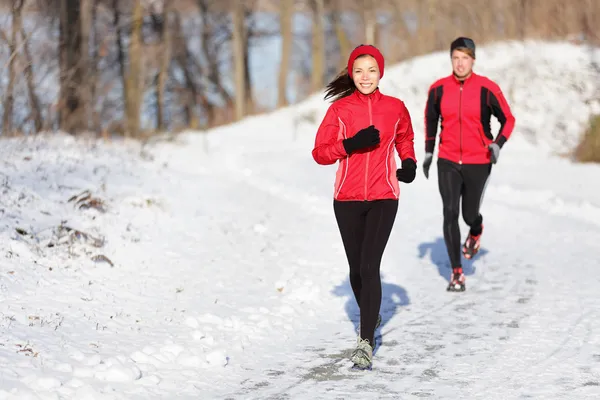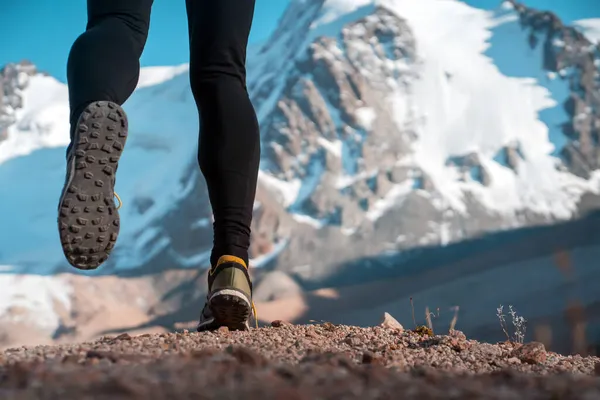Running in Winter: Guidelines and Experience
Revere Greist
What are the main challenges that come with winter running?
Breathing: While brisk air can deliver a shock when colder temperatures first arrive, your body will adjust within each workout and over the course of the winter months. There are many myths about breathing techniques in winter. But the best thing is to breathe naturally, calmly, and measurably. Inhale through the nose and exhale through the mouth.
Footing: running on snowy surfaces is challenging but possible. We cover shoes and traction below, but finding running shoes designed for slippery conditions – including trail running shoes – is a great way to manage low grip and traction situations. And while running snow is possible and necessary, we don’t recommend running on glare ice. If you plan to run in deep snow, be prepared for a workout! It can be comparable to running in sand.

Dress for success!
You should aim to dress to strike a balance between warmth and heat management – in other words, neither too hot nor too cold. But this balance can only be found with experience. Many runners overdress, particularly at the beginning of the fall and winter seasons. Don't wrap yourself in layer after layer, or in heavily insulated clothes. Remember that you will still sweat despite the colder temps. Often, wearing the right clothes for colder conditions means starting your out run feeling a little chilly. On the other hand, conditions can change. Any precipitation and certainly wind can make an underdressed runner miserable and increase the risk of hypothermia. So check the weather and plan for the changes in the conditions.
Layering goes a long way in the winter because it allows you to adapt. We recommend wearing three layers:
- The first layer is a base layer of thermal underwear to prevent hypothermia. The best base layers are constructed of synthetic, sweat-wicking fabrics that keep you dry and help to regulate your temperature. All the major running brands sell base layers designed for cold weather runs.
- The second layer is a fleece. This material maintains warmth and, like thermal underwear, removes moisture. Different weight fleeces work for conditions and types of training: for example, light fleece is suitable for fast running and dense is best for slow jogs and training in severe frost.
- The third layer is wind and waterproof outerwear: it protects against precipitation and wind thanks to the membrane materials from which it is made but also vents body heat and moisture to keep you comfortable. If you plan to run early in the morning or late in the evening, look for reflective outerwear.
Accessorize!
- Leg warmers can keep your connective tissues warm and reduce the risk of injury.
- Water-repellent gloves will keep your hands comfortable.
- Since the head and neck shed a lot of heat during exercise, a hat is essential to staying comfortable. The best hats are the ones that cover your ears, fit well and stay in place during runs at any pace!
- Scarf. In lieu of a traditional scarf, which might not breathe well and can be awkward for running, we recommend using a buff or tube scarf. This is an excellent accessory for any active winter sport!
- Balaklava. An indispensable item, especially in really cold climates, where it reduces the risk of frostbite and protects the skin on your face.
- Bag or fanny pack. If you take extra gear, hydration, or nutrition with you winter runs, a light backpack or fanny pack can be just the ticket. Make sure to find one that’s water-repellent in case you encounter rain or snow, or any precipitation in between!

Put the best foot forward!
Shoes are more complex. Winter running shoes should be made of water-repellent material and provide good traction. At the same time, they should breathe well. Working with a specialist running store can ensure you find shoes that fit, address your style of running, and are tailored toward winter conditions. We advise you to pay attention to the “drop” or difference in height between the forefoot of the shoe and the heel. It’s better to choose a low (1-3 mm) or medium (4-7 mm) drop for winter running. Also, don't forget to consider support and cushioning in your shoes. If you are a beginner, opt for full cushioning throughout the sole. Lack of cushioning increases joint stress and the risk of injury.
Skincare
During the winter, it’s particularly important to take care of your skin. In addition to cold air, condensation from your breath further increases the risk of dryness and damage to the epidermis. Apply a protective cream or lotion with a dense texture before and after a run. If you’re one of the rare people whose capillaries burst in the cold, consult a doctor and take supplements to strengthen your blood vessels. For example, Omega-3 or ascorbic acid.
Hygienic lipstick or balm is another recommendation of ours. This will prevent the skin of the lips from being damaged.
In sunny weather, do not forget about UV protection. Use sunscreen. Remember that snow reflects the sun's rays, and the risk of sunburn increases several times over. This is even more true at altitude. Be careful!
It's better to skip the makeup before winter runs. In the cold season, the pores expand and clog faster. Cosmetics are absorbed into the skin and can lead to breakouts.
Use your judgment!
Winter can be a great season for running, but it’s not always smart to head out. We advise you not to run outside in severe frost - below 10 degrees. We also advise people with asthma, a weak blood vessels, and those who are contraindicated in hypothermia to be careful with winter running. Your doctor can advise you about the effect of winter runs on any health questions. We encourage you to give winter running a try. It can be a great time to develop fitness, embrace the outdoors during a time when many people develop cabin fever, and find solace and peace of mind.
If you’re interested in a training plan for winter runs, check out Zihi! It gives you a personalized training plan that fits your schedule, not the other way around! Zihi also learns how you respond to training and recovery and tailors itself to you. You can find us at www.zihipro.com.
About the author
Revere Greist
Revere Greist is the COO and Co-Founder of Zihi, AI-based endurance sports training platform. With more than 20 years in endurance sports and Kona AG 8th place he is fond of sport science and the most effective ways to be fit for a race.
MBA, COO
Madison, WI